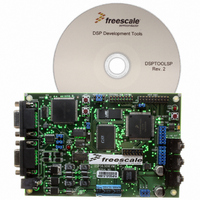DSP56309EVM Freescale Semiconductor, DSP56309EVM Datasheet - Page 8

DSP56309EVM
Manufacturer Part Number
DSP56309EVM
Description
KIT EVALUATION FOR XC56309
Manufacturer
Freescale Semiconductor
Type
DSPr
Specifications of DSP56309EVM
Contents
Module Board, Installation Guide, Power Supply, Cable, Software and more
Description/function
Audio DSPs
Product
Audio Modules
For Use With/related Products
DSP56309
Lead Free Status / RoHS Status
Contains lead / RoHS non-compliant
Debug and Run Code: Debug Perspective
4.2
After the connection to the EVM has been established, the code can be downloaded to the DSP. This is
accomplished with the Debug configuration. To setup a new Debug configuration, use the Run > Debug...
pull down menu. Highlight Freescale 563xx, then click the New button to create a debug configuration or
you can double click on the Freescale 563xx to create the configuration. The Name: and Project: fields
should already be filled out (you can change the name if you desire). Click on the Search Project... button.
The object file (*.cld) for this project should already be chosen, so click the OK button. Then click the
Debug button. Be patient: using the parallel command converter it may take as long as 30 seconds to
download both programs to the DSP.
You can also use the Debug button in the tool bar (which looks like a little green bug). If you click on this
button, Symphony Studio automatically launches the last used Debug configuration, or you can click on
the arrow to the right of the button to access the Debug options (instead of using the pull down menu).
When you launch the Debug Configuration, the new link is listed in the Debug window as well as any notes
or errors in the Console window. After you run a Debug configuration the first time, it becomes available
as a choice in the Run > Debug History pull down menu (and the Debug tool bar button menu) for you
to use; therefore, you do not need to create this configuration again.
After the code is downloaded to the DSP, your Flash memory programming code appears in a window
view below the Debug View. A green highlight tells where the program counter is located in the code. The
green highlight should appear on the first line of the Flash memory programming code (
You can step through the code and watch the green highlight change one line at a time. You can step by
using the Run > Step Into or Step Over pull down menu, clicking on the Step Into or Step Over Debug
View tool bar buttons (which look like yellow arrows), or using the F5 and F6 function keys.
Now the code is ready to run. There are several ways to run the code:
When using any of these methods, the Flash memory programming code runs and it loads the codec code
to the Flash memory of the EVM. When the code is running, control is given to the DSP; therefore, the
windows of the debugger do not update. The Flash memory programming code was written to stop
automatically when it is finished and return control back to the debugger. Thus, when the Flash memory
programming is complete, the debugger windows update, and you can see that the Flash memory
programming code has stopped at a debug instruction.
To stop the Debug process, use the Run > Terminate pull down menu, or click on the Terminate button
in the Debug View window tool bar (this button looks like a red square) when the Debug process is
highlighted in the Debug View window. To remove the Debug process from the Debug View window, click
on the Remove All Terminated Launches button in the Debug View window tool bar (the button looks
like two grey x’s). You can also terminate and remove a Debug processes by right clicking on it in the
Debug View window and choosing Terminate, Terminate and Remove, or even Terminate and Relaunch.
You must terminate the process before it can be removed.
8
•
•
•
•
use the Run > Resume pull down menu.
use the Resume Debug View tool bar button which looks like a green triangle.
right click on the debug process list in the Debug View and choose Resume.
use the F8 function key.
Debug
Using Symphony™ Studio with the DSP563xxEVM, Rev. 0
Freescale Semiconductor
move #$100,r0
).










